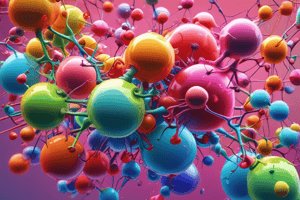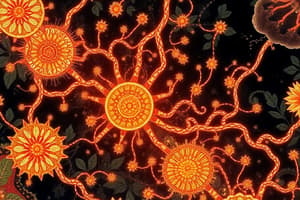Podcast
Questions and Answers
What role do redox enzymes play in biological systems?
What role do redox enzymes play in biological systems?
- They store energy for cellular processes.
- They prevent the breakdown of molecules.
- They only catalyze reduction reactions.
- They catalyze reactions between different molecules. (correct)
Which statement best describes redox reactions in aerobic respiration?
Which statement best describes redox reactions in aerobic respiration?
- They involve only the breakdown of glucose.
- They generate free energy from the breakdown of bonds. (correct)
- They occur in anaerobic organisms.
- They always require energy input to occur.
What process follows glycolysis in aerobic respiration?
What process follows glycolysis in aerobic respiration?
- Electron transport chain
- The Krebs cycle (correct)
- Lipid oxidation
- Fermentation
What is the primary function of the Krebs cycle in aerobic respiration?
What is the primary function of the Krebs cycle in aerobic respiration?
How do spontaneous and nonspontaneous redox reactions differ?
How do spontaneous and nonspontaneous redox reactions differ?
Which of the following organisms rely on aerobic respiration?
Which of the following organisms rely on aerobic respiration?
What is the process that combines chemiosmosis and the electron transport chain?
What is the process that combines chemiosmosis and the electron transport chain?
What is the main effect of competitive inhibitors on enzyme activity?
What is the main effect of competitive inhibitors on enzyme activity?
What happens to the electrons during the redox reaction in glycolysis?
What happens to the electrons during the redox reaction in glycolysis?
Which process is primarily responsible for adding phosphate groups to enzymes?
Which process is primarily responsible for adding phosphate groups to enzymes?
Which factor does NOT affect enzyme activity?
Which factor does NOT affect enzyme activity?
What happens to the reaction rate when substrate concentration exceeds enzyme saturation?
What happens to the reaction rate when substrate concentration exceeds enzyme saturation?
How does temperature generally affect enzyme activity?
How does temperature generally affect enzyme activity?
What does metabolism primarily involve in organisms?
What does metabolism primarily involve in organisms?
Which process is defined as the breakdown of larger molecules into smaller ones?
Which process is defined as the breakdown of larger molecules into smaller ones?
What is the significance of electron transfer in redox reactions?
What is the significance of electron transfer in redox reactions?
Which of the following best defines redox potential?
Which of the following best defines redox potential?
What byproducts are produced at the end of the transition reaction cycle for each glucose molecule entering glycolysis?
What byproducts are produced at the end of the transition reaction cycle for each glucose molecule entering glycolysis?
Which of the following statements about anabolism is true?
Which of the following statements about anabolism is true?
What role does NAD+ play in metabolic reactions?
What role does NAD+ play in metabolic reactions?
Which of the following characterizes catabolism?
Which of the following characterizes catabolism?
What happens to the collision rates between molecules when temperature increases?
What happens to the collision rates between molecules when temperature increases?
What is the saturation point in enzyme-catalyzed reactions?
What is the saturation point in enzyme-catalyzed reactions?
How does increasing substrate concentration affect enzyme activity?
How does increasing substrate concentration affect enzyme activity?
What role do competitive inhibitors play in enzyme activity?
What role do competitive inhibitors play in enzyme activity?
What is one effect of increasing enzyme concentration?
What is one effect of increasing enzyme concentration?
What is the impact of pH levels on enzyme activity?
What is the impact of pH levels on enzyme activity?
Which type of inhibitor does not compete for the active site?
Which type of inhibitor does not compete for the active site?
What could potentially limit the increase of reaction rates when enzyme concentration is increased?
What could potentially limit the increase of reaction rates when enzyme concentration is increased?
What is the primary outcome of photosynthesis?
What is the primary outcome of photosynthesis?
What role do antioxidants play in the body concerning free radicals?
What role do antioxidants play in the body concerning free radicals?
What does saturation level refer to in enzyme activity?
What does saturation level refer to in enzyme activity?
What can happen if there is an imbalance between free radicals and antioxidants?
What can happen if there is an imbalance between free radicals and antioxidants?
Which factor does NOT directly influence enzyme activity?
Which factor does NOT directly influence enzyme activity?
What is the significance of the unpaired electron in free radicals?
What is the significance of the unpaired electron in free radicals?
What does the optimal level refer to in regards to enzymes?
What does the optimal level refer to in regards to enzymes?
How does electron transfer contribute to ATP synthesis?
How does electron transfer contribute to ATP synthesis?
Flashcards
Metabolism
Metabolism
The sum of all chemical reactions occurring within a living organism to sustain life, including energy conversion, waste removal, and molecule production.
Anabolism
Anabolism
A series of chemical reactions that build complex molecules from simpler ones, requiring energy.
Catabolism
Catabolism
A series of chemical reactions that break down complex molecules into simpler ones, releasing energy.
Redox Reactions
Redox Reactions
Signup and view all the flashcards
Transition Reaction
Transition Reaction
Signup and view all the flashcards
Redox Potential
Redox Potential
Signup and view all the flashcards
Oxidation
Oxidation
Signup and view all the flashcards
Reduction
Reduction
Signup and view all the flashcards
Redox Enzymes
Redox Enzymes
Signup and view all the flashcards
Aerobic Respiration
Aerobic Respiration
Signup and view all the flashcards
Glycolysis
Glycolysis
Signup and view all the flashcards
Krebs Cycle
Krebs Cycle
Signup and view all the flashcards
Oxidative Phosphorylation
Oxidative Phosphorylation
Signup and view all the flashcards
Chemiosmosis
Chemiosmosis
Signup and view all the flashcards
Electron Transport Chain
Electron Transport Chain
Signup and view all the flashcards
Photosynthesis
Photosynthesis
Signup and view all the flashcards
Free Radicals
Free Radicals
Signup and view all the flashcards
Antioxidants
Antioxidants
Signup and view all the flashcards
Oxidative Stress
Oxidative Stress
Signup and view all the flashcards
Optimal Enzyme Activity
Optimal Enzyme Activity
Signup and view all the flashcards
Saturation Level
Saturation Level
Signup and view all the flashcards
Enzyme Concentration
Enzyme Concentration
Signup and view all the flashcards
Substrate Concentration
Substrate Concentration
Signup and view all the flashcards
Competitive Inhibition
Competitive Inhibition
Signup and view all the flashcards
Noncompetitive Inhibition
Noncompetitive Inhibition
Signup and view all the flashcards
Enzyme Modification
Enzyme Modification
Signup and view all the flashcards
Phosphorylation
Phosphorylation
Signup and view all the flashcards
Dephosphorylation
Dephosphorylation
Signup and view all the flashcards
Enzyme Saturation
Enzyme Saturation
Signup and view all the flashcards
Temperature & Enzyme Activity
Temperature & Enzyme Activity
Signup and view all the flashcards
pH and Enzyme Activity
pH and Enzyme Activity
Signup and view all the flashcards
Substrate Concentration & Reaction Rate
Substrate Concentration & Reaction Rate
Signup and view all the flashcards
Enzyme Concentration & Reaction Rate
Enzyme Concentration & Reaction Rate
Signup and view all the flashcards
Enzyme Inhibitors
Enzyme Inhibitors
Signup and view all the flashcards
Study Notes
Metabolism
- Metabolism refers to chemical reactions in organisms for maintenance and survival
- Includes energy conversion (from food to sugar), waste removal, and molecule production
Types of Metabolic Reactions
- Anabolism: Building complex molecules from simpler ones (synthesis)
- Catabolism: Breaking down complex molecules into simpler ones (breakdown, releasing energy)
Redox Reactions
- Chemical reactions involving electron transfer
- Involve loss, gain, or transfer of electrons, releasing or absorbing energy
- Oxidation: Loss of electrons
- Reduction: Gain of electrons
- Redox reactions are crucial for many biological functions
Transition Reaction
- Chemical reaction involving Acetyl CoA
- Involves the reduction of NAD+ to NADH
- Produces 4 carbon dioxide, 6 NADH, 2 FADH2, and 2 ATP molecules per glucose molecule
Redox Potential
- Measure of a chemical reaction's tendency to lose/gain electrons
- Quantifies how likely a compound is to be reduced or oxidized
Redox Enzymes
- Enzymes that catalyze redox reactions
- Facilitate electron transfer between molecules
- Important in energy transfer processes
Aerobic Respiration
- Uses oxygen to break down organic molecules for energy
- Involves glycolysis and Krebs cycle
- Glycolysis: Oxidizes glucose, producing NAD+ and pyruvate
- Krebs cycle: Uses glycolysis products to generate ATP, providing electrons/hydrogen for further ATP synthesis
Oxidative Phosphorylation
- Part of aerobic respiration process
- Involves electron transport chain (ETC), chemiosmosis
- Transfer electrons from NADH and FADH2 to generate ATP in mitochondrial inner membrane
Photosynthesis
- Process where organisms convert carbon dioxide and water into oxygen and glucose (with solar energy)
Free Radicals
- Uncharged atoms/molecules with unpaired electrons, highly reactive
- Can damage cellular structures
- Antioxidants neutralize free radicals
Factors Affecting Enzyme Activity
- Temperature: Affects reaction rates, optimal temperature exists
- pH: Enzymes function best at specific pH levels
- Substrate Concentration: High concentration leads to higher reaction rates until saturation
- Enzyme Concentration: Higher concentrations of enzymes lead to faster rates
- Inhibitors: Substances that slow/stop enzyme activity (competitive or noncompetitive)
Studying That Suits You
Use AI to generate personalized quizzes and flashcards to suit your learning preferences.




